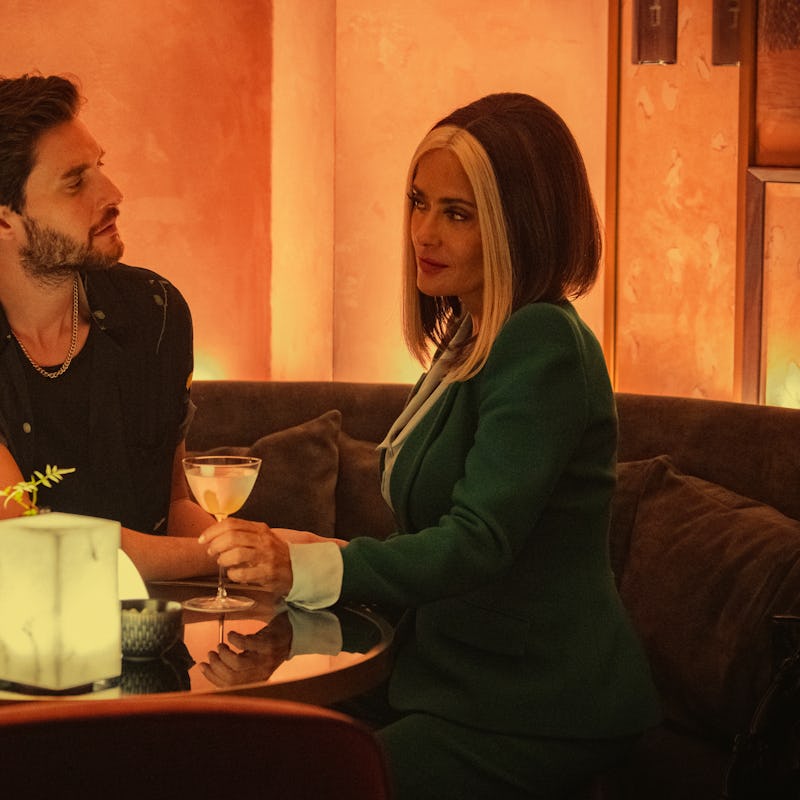Black Mirror Takes a Wild New Direction In Its Most Meta Season Yet
The sixth season of the anthology season turns its camera back at Netflix.

“This is like something out of Black Mirror” has become shorthand in our culture for when technology goes too far, like when an AI generates a screenplay or robotic security guards are deployed. The series has gained a reputation for skewering our over-dependence on technology to the point where writer Daniel M. Lavery summed up the series with one sentiment: “what if phones, but too much?”
But such a specific angle can only take you so far. Black Mirror creator Charlie Brooker, fresh from sparking a Tiktok meme with his mockumentary series Cunk on Earth, seems to have taken the criticism to heart. In Season 6 of the series, not a single story relies on smartphones going too far. The “Black Mirror” no longer refers to your face reflected in your phone screen, but the one reflected in your TV screen.
After Netflix bought the series from British network Channel 4 in 2015, it always seemed like Black Mirror could never really be impartial about technology. After all, it was a streaming series: satires about the internet can only go so far when you need a wi-fi signal to even watch it.
But Season 6 changes all of this from the very first second. “Joan is Awful” is Charlie Brooker’s reaction to all these criticisms. It follows Joan (Annie Murphy) as she goes about her life only to discover a “Peak TV” series called Joan is Awful on the massively popular streaming service Streamberry.
The villain of the piece isn’t Joan (who isn’t, by the way, all that awful) or anyone she knows. The villain is Streamberry itself, taking the Netflix conflict of interest straight to the heart. It’s a new level of audacity, levels of meta-storytelling, and sophistication of story, and is by far the best episode of the season — if not the series as a whole.
Annie Murphy in the season’s standout episode, “Joan is Awful.”
But the deviation from the technology theme is not limited to that episode. In fact, every episode is either about the entertainment industry, like “Loch Henry” or “Mazey Day,” or the implied in-universe stories like faux-70s horror tale “Demon 79.” There are no insidious apps, no heavy-handed social commentary. It’s just the classic Black Mirror lens on subjects like space travel, paparazzi, and true crime.
Now that the series has a wider scope, there are bound to be some missteps. “Mazey Day” feels more like an episode of a certain supernatural CW show than an episode of Black Mirror, and the ‘70s-style of “Demon 79” pales in comparison to fellow British anthology series Inside No. 9’s “The Devil at Christmas,” which used actual vintage 1970s cameras instead of a filter.
Nitpicks aside, this is definitely a new stage in Black Mirror’s evolution. If there ever were any creative restrictions from Netflix, they’re definitely gone now, and the result is Charlie Brooker trying new, riskier story topics in his scripts. Black Mirror has always tried to be on the cutting edge, and now it’s found a way to steer away from the shocking (“The National Anthem”) and preachy (“Men Against Fire”), and instead look inward.
Aaron Paul in the Black Mirror episode “Beyond the Sea.”
Maybe the real problems Black Mirror needed to highlight didn’t lie in cartoon character politicians or Twitter causing people to crash their cars, but in our need to turn our burgeoning dystopia into entertainment. Why do we find comfort in stories of people suffering at the hand of the technology we live by? This show knows that it can’t answer that question but it can make sure it’s not exempt from its own criticism.
Perhaps in the world of Black Mirror, there’s a similar series on Streamberry that cranked out five more episodes about people spending too much time on TikTok. But thankfully we live in the world where even the most steadfast anthology series grows alongside the world — and the worldview — of its viewers.